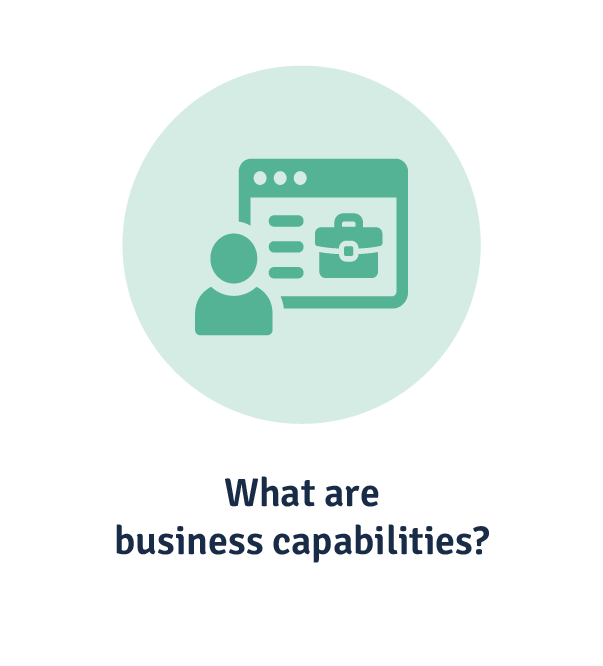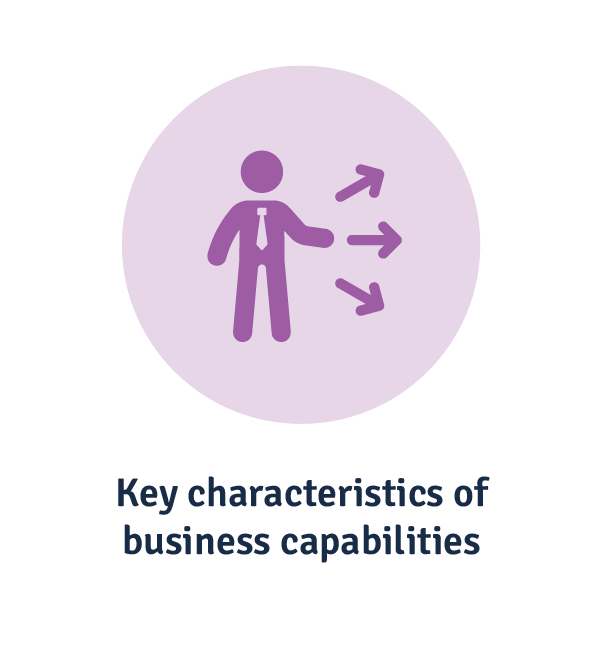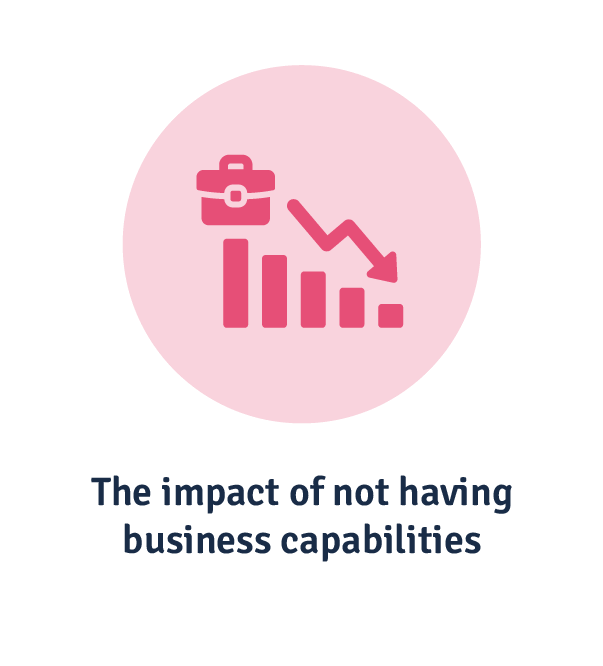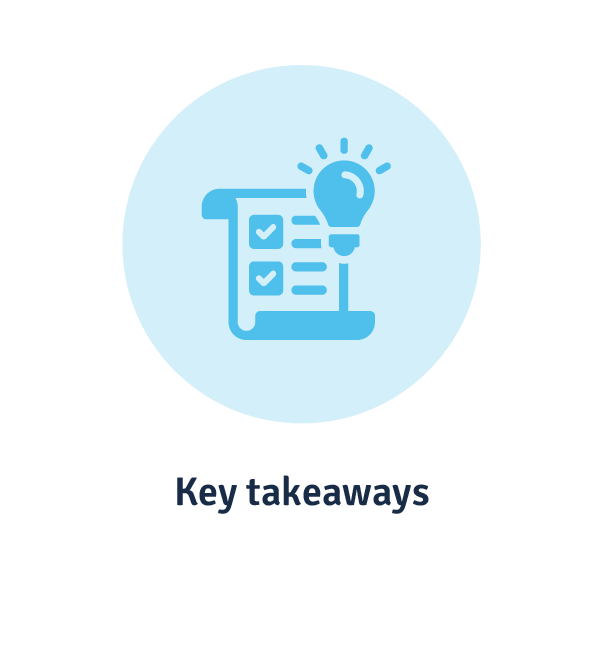What are business capabilities?
A business capability describes the skills, knowledge, processes, systems and other resources an organisation possesses which allows them to achieve their strategic goals, objectives and business functions. They assist in identifying and prioritising what is strategically important for decision-making regarding business processes, driving agility in the face of change, and generating value streams.
The importance of business capabilities
What do business capabilities provide for your organisation, really? Consider business architecture and how different business capabilities come together in your organisational structure. It’s about what your organisation does, why it does it, and how. In other words: How does your business perform core functions to generate business value?
A business capability map (or business capability model) provides a visual representation of your specific business capabilities and their hierarchal relationships to each other, from your top-level business capabilities to day-to-day functions. In general, business capability mapping is used to identify the potential of your business capability, enabling you to better visualise business leaders’ priorities and strategy in a way that all stakeholders, including employees, can grasp.
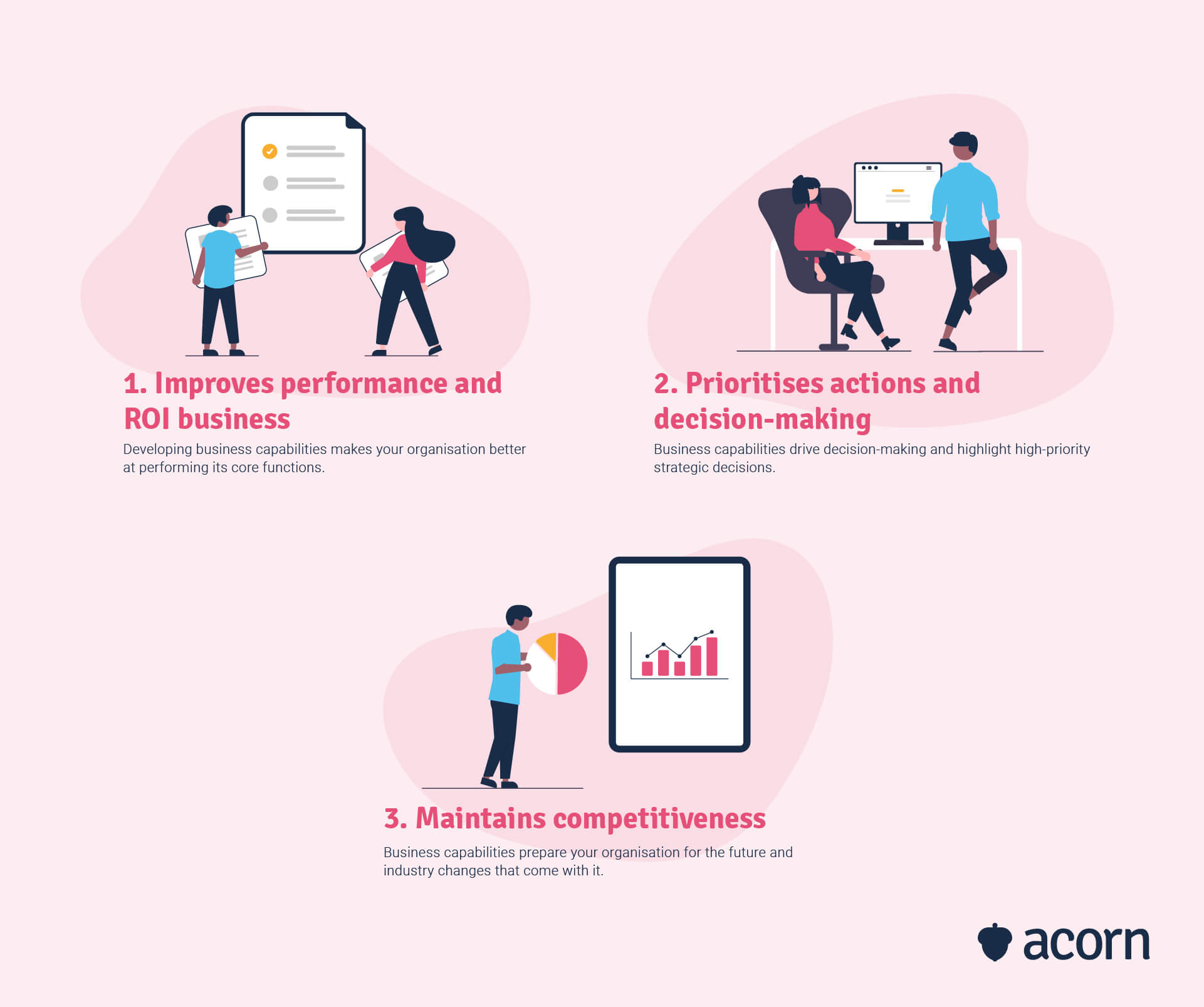
Improves performance and ROI
Your business capabilities are what your organisation does best to perform core functions, so by linking business capabilities with your business needs, your organisation becomes better at performing those specific business capabilities. This leads to more efficient processes, better innovation and increased productivity for reduced cost, driving a greater return on investment.
You can use a performance learning management system (PLMS) to help you link capabilities with strategy, as well as track the uptick in performance. A PLMS is a dynamic AI-powered platform for L&D experiences synchronised to business performance. It’s designed to codify and operationalise capabilities to improve organisational efficiency and performance.
Prioritises decision-making
Because business capability maps show the core capabilities at each level of your organisational structure, it can help strategy execution when it comes to strategic planning.
Look at it this way: You need to define the actions and projects that will help you meet strategic priorities. Clearly defining business capabilities (and where they sit in your business capability map), is a crucial first step to identifying which decisions, actions and projects you should focus on first.
When you have an understanding of your differentiating capabilities, you’ll be able to make more informed strategic investments and decisions around strategy execution, allowing for organisational transformation through the creation of more effective processes and proactive responses to emerging threats.
In short, it’s important for ensuring you’re using your resources in an impactful way that reduces waste and costs.
Maintains a competitive advantage
Business capabilities aren’t set in stone. In fact, having rigid, inflexible business capabilities is only a setback for your organisation, since your industry is constantly changing with new innovations in technology, processes, and strategy. Investing in business capability helps you apply agile principles to assist in risk management. This way, you stay ahead of the curve by closing the capability gaps that arise before they become weaknesses.
In a nutshell: Ongoing capability-based planning powers organisational transformation, and the continuous improvement of your workforce. It leverages and addresses the unique strengths and weaknesses of your workforce to mitigate business risks from industry developments and emerging trends.
Key characteristics of business capabilities
Business capabilities have several key characteristics that distinguish them from other types of organisational assets or resources. You’ll find they are distinct from other business objects in that they are:
- Specific and measurable. Capabilities can be quantified and tracked over time, allowing organisations to understand their strengths and weaknesses, and make data-driven decisions about where to invest and improve.
- Actionable, meaning that they can be directly influenced and managed through specific actions and decisions. Not only does that mean actionable through everyday work, but if an organisational capability assessment flags critical capabilities as at-risk, you’ll be able to develop capacity where it’s needed to fill gaps.
- Dynamic, due to new technology, inventions and processes in the industry and adjusted strategy to match it. Organisations need to continuously monitor and adapt their capabilities to stay competitive and meet the constantly changing needs of their customers and stakeholders.
- Directly derived from and aligned with an organisation’s strategic goals, ensuring that resources, strategic tactics and talent decisions are all truly focused on achieving those objectives.
How to use business capabilities to improve organisational performance
You can use your business capabilities to drive improvement in your organisation’s performance, increasing ROI and agility for the future. How you go about this will depend on the individual needs of your business, but in general, there are five steps you need to follow to utilise your business capabilities for organisational improvement.
- Conduct a capability assessment. This allows you to gain an understanding of your current strengths (such the capabilities you currently possess), as well as any opportunities for improvement (such as capabilities you may not be as mature in, or will be needed in the future).
- Identify key capabilities that align with your organisational goals and objectives. These are derived from your strategic goals to provide a direction for development going forward.
- Develop an actionable plan for building these capabilities in your workforce. These will be the steps you’ll take through training programs to build your business capability and increase performance, productivity, and competitiveness.
- Implement and measure your progress. This will be your progress towards your strategic goals and the effectiveness of your capability development programs.
- Continue to review and adjust business goals and capabilities over time. This is how you improve your organisation over time in line with industry and technological change, maintaining competitiveness.
The impact of not having business capabilities
So, what happens when your organisation fails to define and build business capabilities?
First of all, you won’t have the alignment between your goals and capabilities, which will snowball out into other aspects of your business to affect your performance ROI and ability to remain agile.
Lack of alignment with strategic goals
Your business capabilities are derived from your business goals. From there, your business capability map will show you how each fits into your organisational structure, making it easier for you to align them with your business goals. But when you don’t specify or develop business capability, the skills and knowledge required to transform your organisation and hit your strategic goals will be impossible to pinpoint.
In a survey by Gartner’s TalentNeuron, 53% of respondents said the biggest barrier to organisational transformation was an inability to identify the needed skills to achieve it. Even worse, 31% said they were unable to identify their business-critical skills at all. Which means they aren’t going to have a clear direction for achieving their business goals, or even have clear business goals at all.
Inability to measure performance
How can you measure your progress towards your business goals if you don’t know how you’re closing the gap? The answer is: You can’t.
You need business capability to set your direction for organisational transformation. We mean tangible, actionable steps that you can take to deliver your strategic goals. Without clearly articulated capabilities, you won’t be able to identify strategic areas of weakness. That means that any processes or functions that rely on up-to-date capability data—like L&D and organisational development—will be on the backfoot or making misinformed strategic decisions.
You can’t guarantee any strategic outcomes in that scenario, which means that you have no accurate gauge of performance at both the employee and organisational level. Any success you do achieve is also likely to be unsustainable or irreplicable since you won’t have the blueprint (aka capabilities) to repeat successful events—making for one vicious cycle.
Difficulty adapting to change
LinkedIn’s 2022 Workplace Learning Report found 46% of L&D professionals believe their skills gap was wider in their organisations than the previous year, and 49% said that executives were concerned their employees wouldn’t have the right skills needed to execute their business strategy. Organisations that haven’t defined their business capabilities aren’t going to be able to close those capability gaps to adapt to change. Without a clear vision, your activities to enact organisational can’t progress past an ad hoc maturity, meaning that you won’t see any measurable desired outcomes.
Poor communication and collaboration
Without a business capability definition, not only will you have a hard time communicating business strategy, but you’ll also have a hard time communicating how you’ll meet your strategic goals. That leads to confusion around business priorities and a lack of cohesion in efforts to meet them.
So, what does this mean? In short: You’ll lack the necessary buy-in of your stakeholders and business unit leaders to invest in actions and processes to build your organisational capability.
Difficulty attracting and retaining talent
Business capabilities trickle down to your employees since they are pulling the levers and doing the work to execute said capabilities. So, it’s important that your employees feel like they’re valued as part of the business as a whole, both in terms of their capabilities and their growth as a result of it.
We’ve said it before: Employees who are offered learning opportunities are 25% more satisfied with their jobs and 31% more likely to recommend their workplace, with 94% of employees more likely to stay in their current job if offered professional development.
Look at managers. If you don’t provide them with training in the right management capabilities, they won’t be equipped with the skills to perform their jobs effectively. And if managers lack a particular ability to manage employees efficiently, employees are 50% more likely to find another job. What’s more, potential candidates might refuse to take a role with you if they find out ineffective management or a lack of internal mobility.
Key takeaways
Business capabilities are the fundamental building blocks of an organisation, acting as the blueprint for performance, success and competitiveness.
When you understand and manage them effectively, you can improve business performance, even as the industry undergoes constant change around you. And as long as you make sure to regularly assess your capabilities and align them with your objectives, you’ll have an agile and successful business model.
Related Reads on This Topic

How to Do Capability Mapping Like a Pro
Learn how the capability map can be used to define your current state of business and the gaps to cover for future success…

How to Identify Capabilities When Running Business Architecture
Learn how to create business capabilities to sustain organisational success and position business architecture as true leaders…

Skill vs Capability vs Competency: How to Differentiate the Three
Skill, capability and competency are all important and essential characteristics of an efficient workforce. Learn how the three differ…
